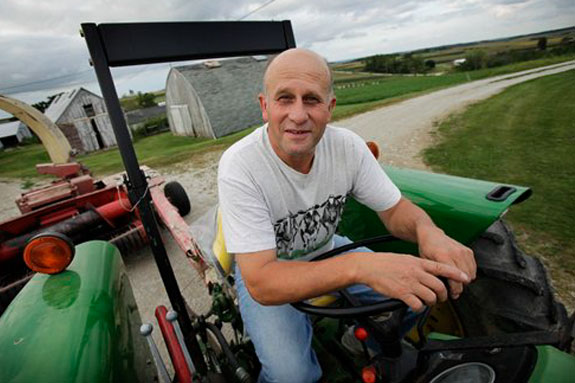Marco's wife and mother, who watched the accident from the family's front porch, raced in terror to the overturned tractor but were relieved to find him with only minor injuries: A steel roll bar and seat belt installed a year and a half ago had saved him from being crushed beneath the machine.
Tractor rollovers have long been the leading cause of death on U.S. farms, accounting for a fifth of all agricultural production deaths over the past two decades.
But they are now declining as farmers like Marco buy new tractors equipped with roll bars, reinforced cabs and seat belts or upgrade older ones with those features.
The rollover protections on Marco's 1966 International Harvester tractor cost $1,300 — half of which was paid for by the state of New York. The 24-year-old said farmers who use older tractors should seriously consider updating them.
"The best message I can give them is I know it's money out of your pocket, but you can't put a price on your life," said Marco, whose family farm is in southern New York's Steuben County near the Pennsylvania state line.
A study published last year by federal researchers found that deaths from tractor rollovers among U.S. agricultural workers fell 28 percent over the past two decades, dropping from 5.5 deaths per 100,000 workers in 1992 to 3.6 deaths per 100,000 in 2007.
The data for 2008 and 2009 have not yet been analyzed to determine whether the trend has continued, said John Myers, a health statistician with the National Institute for Occupational Safety and Health, who co-wrote the study.
Tractor rollovers have been a major cause of farm deaths since the 1920s. Rollover protections weren't introduced for decades, and when they finally became available, they were optional features many chose not to buy.
It wasn't until 1985 that the American Society of Agricultural Engineers adopted them as a voluntary standard that manufacturers quickly adopted, said Dan Neenan, manager of the National Education Center for Agricultural Safety in Peosta, Iowa.
But because tractors are expensive and — unlike automobiles — can run well for decades, many from the 1950s to 1970s remain in use on U.S. farms. Some even date to the late 1940s.
A 2006 survey of farmers showed that about 40 percent of nation's 4.2 million tractors lacked rollover protections, Myers said. But that number is down significantly from 1993, when 62 percent of tractors didn't have them.
Nearly all the change took place from 2004 to 2007, a flush period in agriculture when many farmers replaced or upgraded older tractors, Myers said. Since then, the recession may have slowed the transition since farmers tend to make most of their investments in better equipment when they are doing well financially, he said.
Even in good times, some farmers would rather spend the $1,000 to $2,000 cost of the systems — called Roll Over Protection Structures, or ROPS, in the ag industry — on other things, said Murray Madsen, associate director for the Great Plains Center for Agricultural Health at the University of Iowa.
Others feel that if they've gotten this far without a rollover they don't need protection or believe they could avoid injury if their tractor did overturn.
Lynn Hageman, 58, of Calmar, Iowa, was one of the lucky ones. He was driving his John Deere tractor at dusk last November when a momentary distraction caused him to veer to the right. In an instant, the 10,000-pound machine left the road and toppled into a ditch, pitching him to the ground.
"The first thing I did was move my feet, my legs and my arms to see if I was paralyzed," Hageman said.
He wasn't, and although he was sidelined for six months with back and shoulder injuries, he's still relieved the crash threw him clear of his tractor.
After the accident, he had a roll bar and seat belt installed on his mid-1980s model 2950 John Deere, with insurance footing half of the $600 upgrade. Now, three of his four tractors have rollover protections. He rarely uses the fourth in fields.
Farmers in the Northeast have some of the nation's highest fatality rates from tractor rollovers, due to the region's hilly terrain, small farms with older equipment and a large amount of nonagricultural traffic, said Julie Sorensen, a staff scientist at the Northeast Center for Agricultural and Occupational Health in Cooperstown, N.Y.
To make it more attractive for New York farmers to upgrade older tractors, the state's legislature has provided money to offset some of their costs. The Northeast Center distributes that money through a program that pays for 70 percent of the cost of rollover protections, with a $765-per-tractor limit.
Since 2006, the program has helped pay for upgrades on more than 800 tractors, Sorensen said.
"The program more than pays for itself in lives saved and injuries prevented," she said.
PHOTOS
Lynn Hageman sits on his tractor that has been upgraded with a steel roll bar, Tuesday, Aug. 31, 2010, on his farm near Calmar, Iowa. Hageman was driving his John Deere tractor to a cornfield last November when a momentary distraction caused him to veer from the road, toppling the 10,000-pound machine into a ditch and pitching him violently to the ground.
--Story and photos from AP newswire









